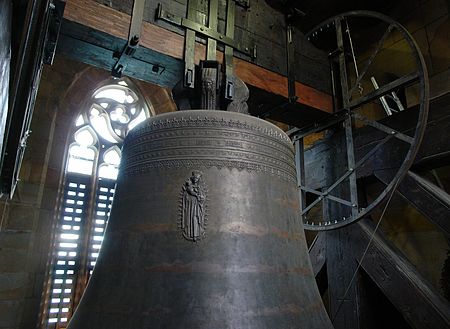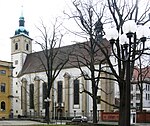Maria Gloriosa

Maria Gloriosa, or the Erfurt Bell, is a well-known bell of Erfurt Cathedral, cast by Geert van Wou in 1497. The world's largest medieval free-swinging bell, it is now swung electrically. It was welded in 1985 to repair a crack, then, in August 2004, the bell was re-fused due to another crack from 2001. Diameter: 8 feet 5+3⁄4 inches [2,584 mm], weight: 13 tons 15 cwts. [12555 kg], note: E [1497 standard]. Alternately: 2570mm, 11450 kg, note by today's standards: F-. It is about 2 meters tall.As with any well-tuned bell the hum tone is near an octave below the strike tone, and all other notes are in tune including the minor third, fifth, octave, and major third and fifth in the second octave that may be heard in large bells.
Excerpt from the Wikipedia article Maria Gloriosa (License: CC BY-SA 3.0, Authors, Images).Maria Gloriosa
Domstufen, Erfurt Altstadt
Geographical coordinates (GPS) Address Phone number Website Nearby Places Show on map
Geographical coordinates (GPS)
| Latitude | Longitude |
|---|---|
| N 50.9758 ° | E 11.0234 ° |
Address
Erfurter Dom (Propsteikirche Beatae Mariae Virginis;Hohe Domkirche St. Marien zu Erfurt)
Domstufen 1
99084 Erfurt, Altstadt
Thuringia, Germany
Open on Google Maps










